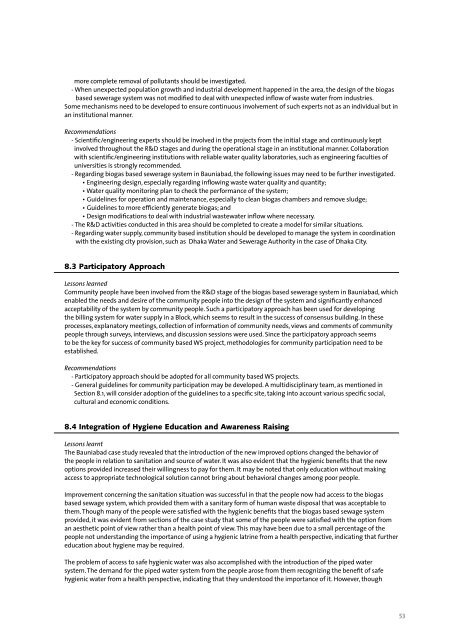Untitled - UNU-IAS - United Nations University
Untitled - UNU-IAS - United Nations University
Untitled - UNU-IAS - United Nations University
You also want an ePaper? Increase the reach of your titles
YUMPU automatically turns print PDFs into web optimized ePapers that Google loves.
more complete removal of pollutants should be investigated.<br />
- When unexpected population growth and industrial development happened in the area, the design of the biogas<br />
based sewerage system was not modified to deal with unexpected inflow of waste water from industries.<br />
Some mechanisms need to be developed to ensure continuous involvement of such experts not as an individual but in<br />
an institutional manner.<br />
Recommendations<br />
- Scientific/engineering experts should be involved in the projects from the initial stage and continuously kept<br />
involved throughout the R&D stages and during the operational stage in an institutional manner. Collaboration<br />
with scientific/engineering institutions with reliable water quality laboratories, such as engineering faculties of<br />
universities is strongly recommended.<br />
- Regarding biogas based sewerage system in Bauniabad, the following issues may need to be further investigated.<br />
• Engineering design, especially regarding inflowing waste water quality and quantity;<br />
• Water quality monitoring plan to check the performance of the system;<br />
• Guidelines for operation and maintenance, especially to clean biogas chambers and remove sludge;<br />
• Guidelines to more efficiently generate biogas; and<br />
• Design modifications to deal with industrial wastewater inflow where necessary.<br />
- The R&D activities conducted in this area should be completed to create a model for similar situations.<br />
- Regarding water supply, community based institution should be developed to manage the system in coordination<br />
with the existing city provision, such as Dhaka Water and Sewerage Authority in the case of Dhaka City.<br />
8.3 Participatory Approach<br />
Lessons learned<br />
Community people have been involved from the R&D stage of the biogas based sewerage system in Bauniabad, which<br />
enabled the needs and desire of the community people into the design of the system and significantly enhanced<br />
acceptability of the system by community people. Such a participatory approach has been used for developing<br />
the billing system for water supply in a Block, which seems to result in the success of consensus building. In these<br />
processes, explanatory meetings, collection of information of community needs, views and comments of community<br />
people through surveys, interviews, and discussion sessions were used. Since the participatory approach seems<br />
to be the key for success of community based WS project, methodologies for community participation need to be<br />
established.<br />
Recommendations<br />
- Participatory approach should be adopted for all community based WS projects.<br />
- General guidelines for community participation may be developed. A multidisciplinary team, as mentioned in<br />
Section 8.1, will consider adoption of the guidelines to a specific site, taking into account various specific social,<br />
cultural and economic conditions.<br />
8.4 Integration of Hygiene Education and Awareness Raising<br />
Lessons learnt<br />
The Bauniabad case study revealed that the introduction of the new improved options changed the behavior of<br />
the people in relation to sanitation and source of water. It was also evident that the hygienic benefits that the new<br />
options provided increased their willingness to pay for them. It may be noted that only education without making<br />
access to appropriate technological solution cannot bring about behavioral changes among poor people.<br />
Improvement concerning the sanitation situation was successful in that the people now had access to the biogas<br />
based sewage system, which provided them with a sanitary form of human waste disposal that was acceptable to<br />
them. Though many of the people were satisfied with the hygienic benefits that the biogas based sewage system<br />
provided, it was evident from sections of the case study that some of the people were satisfied with the option from<br />
an aesthetic point of view rather than a health point of view. This may have been due to a small percentage of the<br />
people not understanding the importance of using a hygienic latrine from a health perspective, indicating that further<br />
education about hygiene may be required.<br />
The problem of access to safe hygienic water was also accomplished with the introduction of the piped water<br />
system. The demand for the piped water system from the people arose from them recognizing the benefit of safe<br />
hygienic water from a health perspective, indicating that they understood the importance of it. However, though<br />
53
















